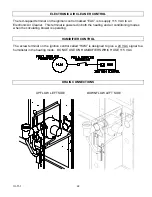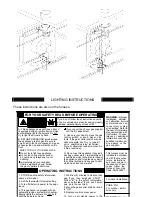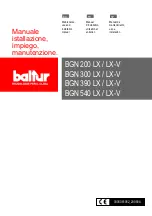
IO-151
9
drain to the terminal. This will allow the condensate to flow backwards into the drain system and
not out the terminal. When penetrating the structure to the outdoors install a sleeve to allow for
expansion and contraction. Vertical runs must be supported a minimum of every six (6) feet.
DO NOT
rigidly support the vent pipe, always allow for expansion and contraction.
JOINING PIPE AND FITTINGS
Observe all cautions stated on the cement label.
DO NOT
CEMENT THE PIPE OR FITTINGS DIRECTLY TO THE VENTER. A RUBBER BOOT
AND HOSE CLAMPS ARE PROVIDED FOR THIS PURPOSE.
CONDENSATE DRAIN
This furnace is designed to remove both sensible and latent heat from the combustion flue gas.
As a result water vapor is condensed in the secondary heat exchanger. This condensate must be
drained either to the outdoors or, where local code permits, to a sewage system.
In areas where floor level drains are not available a condensate pump may be employed. This
condensate pump must be constructed of corrosion resistant materials. It must also have an
auxiliary switch which will shut down the furnace in the event of pump failure or drain tube
blockage.
DO NOT
run the condensate drain to an outdoor drain or to an unheated area where the
possibility of freezing may occur. If installed above a ceiling or other areas where condensate
overflow may cause damage, due to drain freezing or blockage, an auxiliary drain pan draining to
the outdoors is required.
Note
: Some local codes require this condensate to be neutralized prior to disposal.
See illustrations elsewhere in this I&O for proper drain connections.
GAS PIPING & GAS PIPE CAPACITY TABLE
Check the rating plate to make certain that the gas supplied is compatable with the unit
requirements. Care should be taken after the installation of this appliance that the gas control
valve is not subjected to high gas supply line pressure.
In making connections, avoid strains as they may cause noise and damage the controls. Always
use a back-up wrench when tightening the gas supply pipe to the gas control valve. Check for
leaks in the gas supply using soap bubbles or other approved methods.
NEVER USE AN OPEN FLAME TO CHECK FOR GAS LEAKS. THIS PRACTICE MAY CAUSE A
FIRE, EXPLOSION, BODILY HARM OR PROPERTY DAMAGE.
Pipe joint compound must be resistant to the action of LP gas. When connecting the gas service
to the furnace, a ground joint union and manual shutoff must be installed exterior to the furnace
cabinet so the control assembly may be easily removed.
A 1/8” NPT plug on the supply pipe near the manual valve for the purpose of making pressure
measurement must also be installed. The valve should be readily accessible for turning on or off.
A capped sediment trap, sometimes called a drip leg, must be installed in the gas supply pipe as
close to the furnace as possible. The sediment trap must incorporate a change of gas flow
direction.
Refer to local codes or the above mentioned publications for proper location and size of the
manual shutoff and sediment trap lengths.
The gas pipe must be sized to eliminate undue pressure drop. See pipe capacity table or consult
your local utility.






































